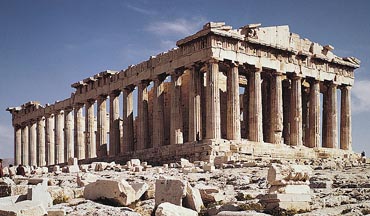Supplementary Web page
Supplementary Web page
Know the terms included on the page dedicated to Arches and Vaults.
Forum (pl. fora): the public square in a Roman city or town. In Rome individual emperors constructed their own fora (Imperial fora).
Trabeated- having horizontal beams or lintels rather than arches.
Arcuated- architecture based on the use of arches and vaults.
Ashlar masonry- the use of cut blocks of stone to construct a structure.
Basilica- originally any large hall, as the public halls erected by the Romans on the fora, or public square, of their towns. They served as a municipal meeting place, being used as law courts, stock exchanges, etc. The term was adopted by the Early Christians to designate their churches which retained some of the feature of the familiar secular meeting places.

|
  
|
| Parthenon, 447-432 B.C., Athens. | Pantheon, 118-25 A.D., Rome |
Compare and contrast these two buildings. Your answer should
include a discussion of the different approaches to space, structural
techniques, and building materials. In your discussion of space
you should discuss the relationship of the buildings to surrounding
structures. Make sure that you also note important similarities
between the two. Your discussion should bring out how each is
characteristic of the civilization which produced it.